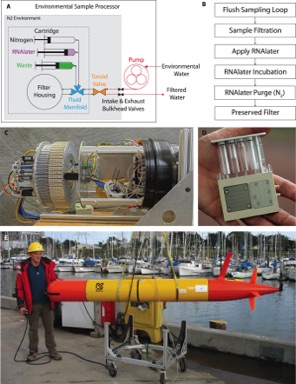AUV Technology
Annotated list with links to reports or papers.

Instruments, Sensors and Samplers
Recent concepts, developments and practical experience
Many of the instruments sensors and samplers on AUVs deployed in the Polar Regions will be off-the-shelf items from commercial suppliers, with very little, if any, difference from those used in temperate waters. The breadth of instruments, sensors and samplers used on AUVs under ice can be gleaned from the many papers in other sections of this website, e.g. the Chronology and AUV Technology overview. This section contains examples of new technologies, or new combinations of technologies or reviews of the challenges still facing sensing and sampling the marine environment.
Combined Dopper and Correlation velocity log and profiler
The Syrinx instrument from Sonardyne combines a number of capabilities that can offer benefits over previous generations of Doppler velocity logs:
• Enhanced performance by having available Dopper and Correlation signal processing and beam patterns, with the most appropriate method being used where each is best suited. For example, the Correlation method is more suited to very low speed operations, including hover, down to very low altitudes (less than one metre), with low bias errors.
• Ability to cope with steep terrain, including near-vertical gradients, with an adaptive algorithm to provide reliable bottom lock.
• Designed to enable seamless integration with the SPRINT inertial navigation instrument, e.g. the SPRINT-Nav 700 as installed on the UK National Oceanography Centre's AUI2K under ice AUV.
• ADCP mode for water current profiling with up to 255 cells, and easily used as an upward-looking instrument.
Trace metal micronutrient samplers
In a wide-ranging review paper Grand et al. (2019) set out four challenges that need further effort and resources to enable autonomous determinations of oceanic trace metal micronutrients (including cobalt, copper, iron, manganese, nickel and zinc):
• Improve sensitivity of existing sensors, including new chemical assays, to achieve a best compromise between precision, detection limits, speciation and long-term stability.
• Reduce size and power requirements - using metrics such as Joules per measurement to gain a better-informed picture.
• Improve pathways to take-up by scientists of new lab- and industry-developed sensors, and routes for adapting commercial instruments designed for non-marine applications, e.g. biomedicine.
• Develop community-led standard protocols for evaluation, e.g. of endurance and comparability with existing lab-based methods. The Alliance for Coastal Technologies (ACT) is doing sterling work in related areas, including recent reports on eDNA sampling and sample processing, hyperspectral radiometers and Harmful Algal Bloom toxins detection.
eDNA sampling and sample processing
Detecting organisms, or functional groups, e.g. those that fix nitrogen, the marine environment using eDNA is an area of rapid development with definite promise for deployment on future polar and under ice AUV missions. In a detailed report the Alliance for Coastal Technologies have collected together useful advice from working groups and subject matter experts. Points addressing the need for caution when collecting and processing samples certainly apply to samplers that will be deployed on AUVs, including:
• Conduct pilot studies for the species or functional groups of interest to optimise sampling volume and experiment design. Give special attention to filters.
• Create consistent collection protocols, especially to reduce contamination.
• Understand and report biases during PCR amplification.
• Interpret, share and report results, and share samples with others for independent analysis.
Composite showing: (top) the process flow diagram for the MBARI third generation Environmental Sample Processor (3G-ESP); (centre) arrangement of the 60 sample-holding cartridges arranged around a toroid valve, with a detailed view of a sample cartridge; (bottom) the 3G-ESP is a regular payload for MBARI's Tethys long range AUV, from Yamahara et al. (2019).

Example of a microfluidic phosphate analyzer that is self-calibrating, with an accuracy similar to bench instruments over two-month deployments, from Grand et al. (2017). Such analyzers are well suited for use on long endurance AUVs.
